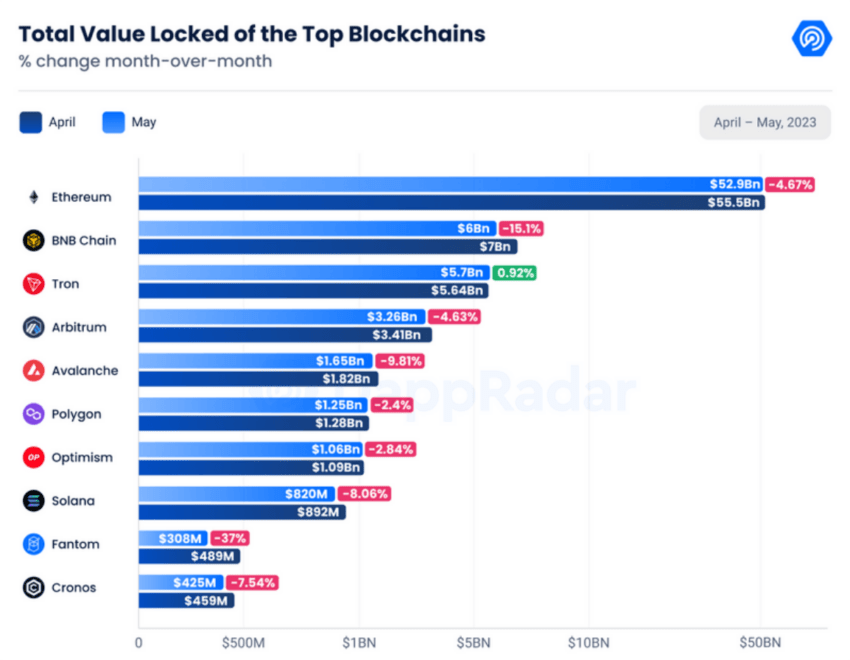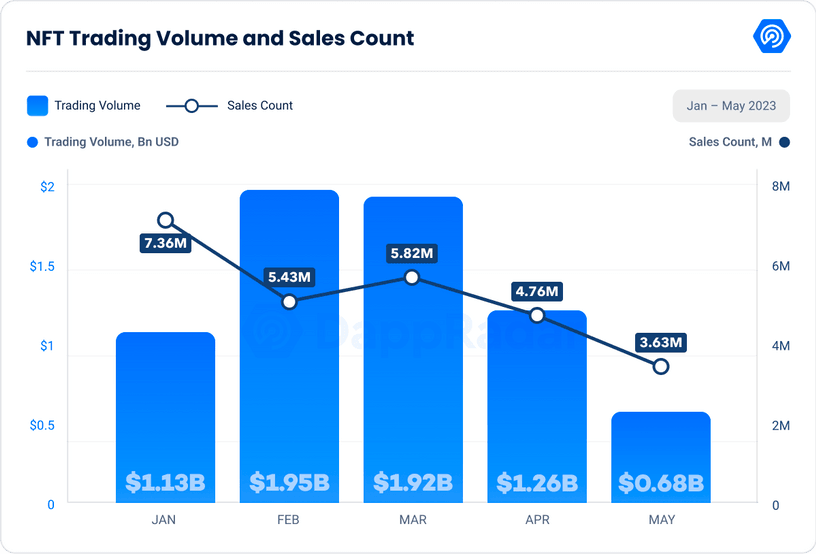dApp Market Grows 10% in May, DeFi TVL Falls Back 4.3%

The industry experienced a mixed performance in May, with DeFi seeing a decrease in total value locked (TVL) but an increase in its share of on-chain activity. The dApp industry grew, while blockchains, except for Tron, regressed in TVL.
According to the latest DappRadar report, the crypto industry had a mixed bag in May, with different parts of the industry simultaneously progressing and taking steps back.
Blockchain TVL Regresses
The total value locked (TVL) in DeFi protocols—or the funds being used in them—saw a 4.3% decrease in May, slipping to $79.16 billion USD. However, DeFi’s share of on-chain activity rose to 31%. So even though more users are taking advantage of its protocols, they’re playing with less collectively.
It wasn’t all bad, though. The dApp industry grew by 9.97% in May, reaching an average of 1,967,051 daily unique active wallets (dUAW), reflecting a steady increase in web3 interest.

Total Value Locked (TVL) Top Blockchains, April-May 2023. Source: DappRadar
Regression was the key takeaway for blockchains in May, as TVL dropped almost across the board. One exception in the report was TRON, which grew a little under 1% over the month.
The biggest loser in this time period was Fantom (FTM). Its TVL dropped by 37% to $308 million due to its association with the Multichain turmoil caused by rumors of potential arrests in China. Multichain’s native token, MULTI, experienced a severe 49% decline, affecting Fantom’s assets and triggering a shift to Arbitrum.
NFT Trading Volumes Down
The NFT market experienced a mixed performance in the past month, reflecting a broader trend in the industry. Trading volume dropped below $1 billion for the first time since December 2022, with May’s NFT trading volume declining sharply by 44% to $675 million compared to the previous month.

NFT Trading Volume and Sale Count. Source: DappRadar
In May 2023, Blur took a 65% market share and earned $442 million in NFT sales. The former king of the NFT marketplaces, OpenSea, had a 27% market share and $183 million in revenue. Despite Blur’s dominance, OpenSea had a significantly higher number of traders, with 377,087, than Blur’s 36,673. This reflects something we’ve known for a long time: Blur appeals to a certain kind of market participant. Namely, those who want a technical focus on higher-frequency trading and less on collecting.
However, Blur’s NFT lending service, Blend, has taken some attention away from its trading platform. NFT traders’ moving from the former to the latter has significantly contributed to the decline in trading volume.






 Bitcoin
Bitcoin  Ethereum
Ethereum  Tether
Tether  USDC
USDC  TRON
TRON  Dogecoin
Dogecoin  Cardano
Cardano  Chainlink
Chainlink  Stellar
Stellar  Bitcoin Cash
Bitcoin Cash  Hedera
Hedera  LEO Token
LEO Token  Litecoin
Litecoin  Monero
Monero  Cronos
Cronos  Dai
Dai  Ethereum Classic
Ethereum Classic  OKB
OKB  Algorand
Algorand  Gate
Gate  Cosmos Hub
Cosmos Hub  VeChain
VeChain  KuCoin
KuCoin  Tether Gold
Tether Gold  Stacks
Stacks  Tezos
Tezos  Theta Network
Theta Network  IOTA
IOTA  Zcash
Zcash  TrueUSD
TrueUSD  NEO
NEO  Polygon
Polygon  Decred
Decred  Dash
Dash  Synthetix Network
Synthetix Network  Basic Attention
Basic Attention  Zilliqa
Zilliqa  Qtum
Qtum  Ravencoin
Ravencoin  0x Protocol
0x Protocol  Holo
Holo  Siacoin
Siacoin  DigiByte
DigiByte  Waves
Waves  Enjin Coin
Enjin Coin  Nano
Nano  Ontology
Ontology  Status
Status  Hive
Hive  Lisk
Lisk  Pax Dollar
Pax Dollar  Steem
Steem  Numeraire
Numeraire  BUSD
BUSD  Huobi
Huobi  OMG Network
OMG Network  NEM
NEM  Bitcoin Gold
Bitcoin Gold  Ren
Ren  Augur
Augur